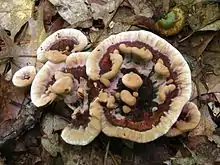Hydnellum scrobiculatum
Hydnellum scrobiculatum, commonly known as the ridged tooth, is a tooth fungus in the family Bankeraceae. Widely distributed in the Northern Hemisphere, it is found in Asia, Europe, and North America.
| Hydnellum scrobiculatum | |
|---|---|
 | |
| Scientific classification | |
| Domain: | Eukaryota |
| Kingdom: | Fungi |
| Division: | Basidiomycota |
| Class: | Agaricomycetes |
| Order: | Thelephorales |
| Family: | Bankeraceae |
| Genus: | Hydnellum |
| Species: | H. scrobiculatum |
| Binomial name | |
| Hydnellum scrobiculatum | |
| Synonyms[1] | |
| |
Taxonomy
The fungus was first described as a species of Hydnum by Elias Magnus Fries in his 1815 work Observationes mycologicae.[7] Petter Karsten transferred it to the genus Hydnellum in 1879.[8] Canadian mycologist Kenneth A. Harrison published the variety H. scrobiculatum var. zonatum as a new combination in 1961,[9] but this is now considered to be synonymous with Hydnellum concrescens.[10] Common names given to the species include "pitted corky spine fungus",[11] and the British Mycological Society recommended name "ridged tooth".[12]
Description
Fruitbodies of Hydnellum scrobiculatum have centrally depressed caps measuring 2–6 cm (0.8–2.4 in) in diameter. These caps can fuse together to form concrescent fruitbodies. The caps have wavy edges, and an initially felty surface that becomes scaly with age. Young fruit bodies are white, then pinkish-brown, then purplish brown, sometimes with white margins.[13] Fruitbodies can become shiny in age.[14]
The spines on the cap underside are up to 4 mm long. They are initially white, but become purplish brown in maturity.[13] The spines are decurrent—they run down the length of the stipe.[15] The stipe, which is roughly the same color as the cap, measures 2–3 cm (0.8–1.2 in) long by 1–1.5 cm (0.4–0.6 in) thick.[13] Mycelium at the base of the stipe envelops and grows around forest litter.[15] The flesh smells mealy (similar to freshly ground flour).[11] The edibility of the fruitbody was previously unknown, but Roger Phillips calls it "poor".[16] In general, Hydnellum species are too acrid and woody to be palatable.[17]
Like all Hydnellum species, H. scrobiculatum produces a brown spore print.[14] Individual spores have a more or less spherical shape, with dimensions of 5.5–6.5 by 4–5.6 μm. They have wart-like projections (tubercles) on the surface. The basidia (spore-bearing cells) are narrowly club-shaped, four-spored, and measure 23–29 by 5–6.5 μm.[11]
Similar species
There are several species that Hydnellum scrobiculatum is often confused with—especially older specimens. These include H. spongiosipes, H. ferrugineum, and H. concrescens.[18] The latter species is particularly similar to H. scrobiculatum, a fact that has been highlighted by conservation efforts in the UK.[19][20]
Habitat and distribution
Hydnellum scrobiculatum fruits singly, in clusters, or in fused groups in both coniferous and mixed forest. It is found in Asia, Europe, and North America.[11] In the United Kingdom, it is considered vulnerable according to the biodiversity action plan for stiped hydnoid fungi,[21] and endangered according to the Red Data List.[14]
References
- "GSD Species Synonymy: Hydnellum scrobiculatum (Fr.) P. Karst". Species Fungorum. CAB International. Retrieved 2015-01-13.
- Karsten PA. (1882). "Rysslands, Finlans och den Skandinaviska halföns Hattsvampar. Sednare Delen: Pip-, Tagg-, Hud-, Klubb- och Gelésvampar". Bidrag till Kännedom av Finlands Natur och Folk (in Finnish). 37: 108.
- Britzelmayr M. (1892). Hymenomyceten aus Südbayern 11 (Theil VIII): Polyporei, Hydnei, Thelephorei, Clavariei und Tremellinei (in German). Berlin: R. Friedländer & Sohn. p. 14.
- Britzelmayr M. (1894). "Hymenomyceten aus Südbayern 13 (Theil X): tekst + index". Berichte des Naturwissenschaftlichen Vereins Schwaben Neuburg (in German). 31: 177.
- Engler A, Prantl K (1900). Die natürlichen Pflanzenfamilien nebst ihren Gattungen und wichtigeren Arten insbesondere den Nutzpflanzen : I. Tl., 1. Abt.: Fungi (Eumycetes) (in German). Leipzig: Englemann. p. 148.
- Maas Geesteranus RA. (1957). "The stipitate hydnums of the Netherlands. II. Hydnellum P. Karst". Fungus. 27 (1–4): 50–71.
- Fries EM. Observationes mycologicae (in Latin). Vol. 1. Copenhagen: Gerh. Bonnier. p. 143.
- Karsten PA. (1879). "Symbolae ad mycologiam Fennicam. VI". Meddelanden Af Societas Pro Fauna et Flora Fennica. 5: 5–46 (see p. 41).
- Harrison KA. (1961). The Stipitate Hydnums of Nova Scotia. Publications of the Department of Agriculture Canada (Report). Vol. 1099. Ottawa, Canada: Research Branch, Canada Department of Agriculture. pp. 1–60.

- "Hydnellum scrobiculatum var. zonatum (Batsch) K.A. Harrison". Index Fungorum. CAB International. Retrieved 2015-01-13.
- Pegler DN, Roberts PJ, Spooner BM (1997). British Chanterelles and Tooth Fungi. Kew, UK: Royal Botanic Gardens. p. 84. ISBN 978-1-900347-15-0.
- "Recommended English Names for Fungi in the UK" (PDF). British Mycological Society. Archived from the original (PDF) on 2011-07-16.
- Ellis JB, Ellis MB (1990). Fungi without Gills (Hymenomycetes and Gasteromycetes): An Identification Handbook. London: Chapman and Hall. p. 106. ISBN 978-0-412-36970-4.
- Phillips R. (2013). Mushrooms: A comprehensive Guide to Mushroom Identification. Pan Macmillan. p. 324. ISBN 978-1-4472-6402-6.
- Huffman DM, Tiffany LH, Knaphaus G, Healy RA (2008). Mushrooms and Other Fungi of the Midcontinental United States. University of Iowa Press. p. 227. ISBN 978-1-58729-725-0.
- Phillips, Roger (2010). Mushrooms and Other Fungi of North America. Buffalo, NY: Firefly Books. p. 323. ISBN 978-1-55407-651-2.
- Arora D. (1986). Mushrooms Demystified. Berkeley, California: Ten Speed Press. pp. 623–27. ISBN 978-0-89815-169-5.
- Polèse JM, Deconchat C (2002). Champignons. L'encyclopédie (in French). Editions Artemis. p. 139. ISBN 978-2-84416-145-1.
- Parfitt D, Ainsworth AM, Simpson D, Rogers HJ, Boddy L (2007). "Molecular and morphological discrimination of stipitate hydnoids in the genera Hydnellum and Phellodon". Mycological Research. 111 (7): 761–77. doi:10.1016/j.mycres.2007.05.003. PMID 17681224.
- Ainsworth AM, Parfitt D, Rogers HJ, Boddy L (2010). "Cryptic taxa within European species of Hydnellum and Phellodon revealed by combined molecular and morphological analysis". Fungal Ecology. 3 (2): 65–80. doi:10.1016/j.funeco.2009.07.001.
- Brodge PD, Panchal G (2004). Number 557. Population diversity and speciation in Hydnellum and Phellodon species (PDF) (Report). English Nature Research Reports. English Nature. ISSN 0967-876X.
Further reading
- info from here